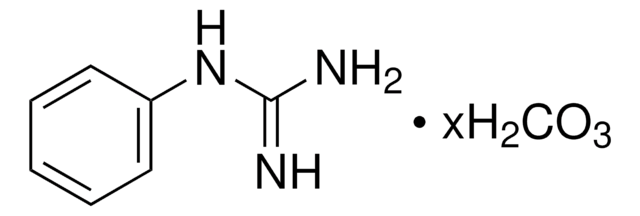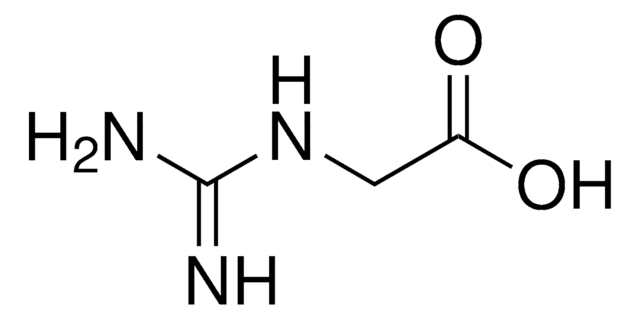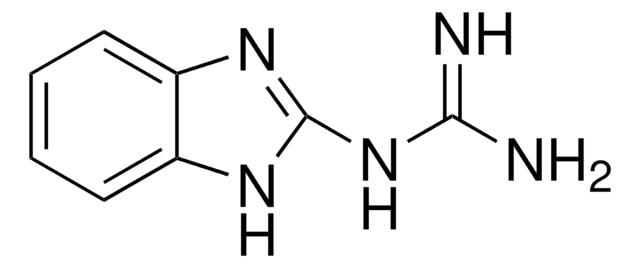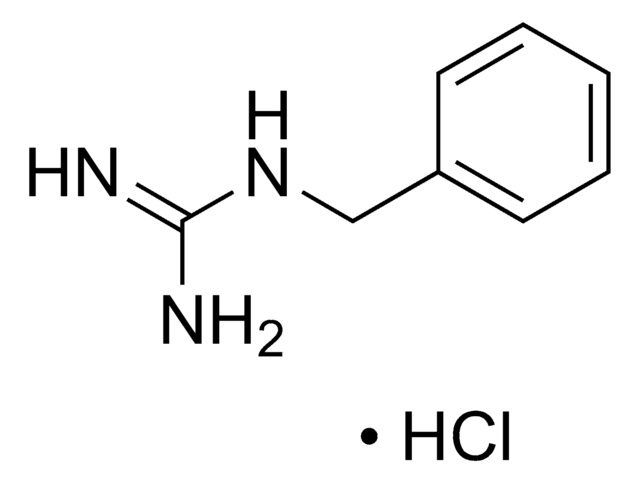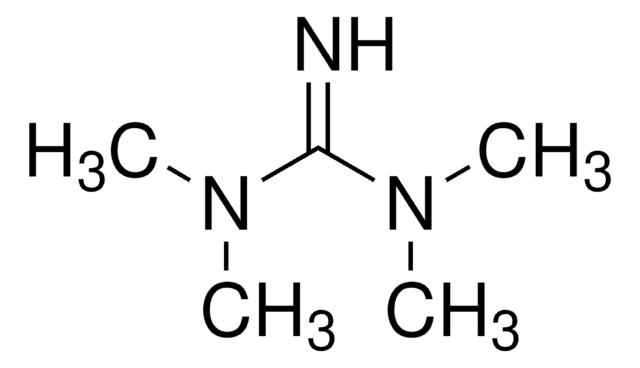About This Item
Fórmula linear:
CH3NHC(=NH)NH2·HCl
Número CAS:
Peso molecular:
109.56
Número MDL:
Código UNSPSC:
12352100
ID de substância PubChem:
NACRES:
NA.22
Produtos recomendados
Nível de qualidade
Ensaio
98%
forma
solid
solubilidade
water: soluble 50 mg/mL, clear
grupo funcional
amine
cadeia de caracteres SMILES
Cl.CNC(N)=N
InChI
1S/C2H7N3.ClH/c1-5-2(3)4;/h1H3,(H4,3,4,5);1H
chave InChI
VJQCNCOGZPSOQZ-UHFFFAOYSA-N
Procurando produtos similares? Visita Guia de comparação de produtos
Categorias relacionadas
Aplicação
Methylguanidine hydrochloride can be used to prepare:
- Biaryl derivatives as BACE1 inhibitors.
- Modified xylose, which is used in the synthesis of biodegradable composite hydrogels.
- Methylguanidinium borohydride ionic liquid, which is applicable as a hydrogen storage material.
Palavra indicadora
Warning
Frases de perigo
Declarações de precaução
Classificações de perigo
Acute Tox. 4 Oral - Eye Irrit. 2 - Skin Irrit. 2
Código de classe de armazenamento
11 - Combustible Solids
Classe de risco de água (WGK)
WGK 3
Ponto de fulgor (°F)
Not applicable
Ponto de fulgor (°C)
Not applicable
Equipamento de proteção individual
dust mask type N95 (US), Eyeshields, Gloves
Escolha uma das versões mais recentes:
Já possui este produto?
Encontre a documentação dos produtos que você adquiriu recentemente na biblioteca de documentos.
Os clientes também visualizaram
A non-covalent strategy for montmorillonite/xylose self-healing hydrogels
Qi X, et al.
Royal Society of Chemistry Advances, 5(51), 41006-41012 (2015)
Jared N Cumming et al.
Bioorganic & medicinal chemistry letters, 22(7), 2444-2449 (2012-03-07)
From an initial lead 1, a structure-based design approach led to identification of a novel, high-affinity iminohydantoin BACE1 inhibitor that lowers CNS-derived Aβ following oral administration to rats. Herein we report SAR development in the S3 and F' subsites of
Jovana Vušurović et al.
ChemistryOpen, 6(6), 739-750 (2017-12-12)
Interactions of ribonucleic acid (RNA) with guanidine and guanidine derivatives are important features in RNA-protein and RNA-drug binding. Here we have investigated noncovalently bound complexes of an 8-nucleotide RNA and six different ligands, all of which have a guanidinium moiety
S Lotze et al.
The Journal of chemical physics, 142(21), 212436-212436 (2015-06-08)
We study the interaction between the ions methylguanidinium and trifluoroacetate dissolved in D2O and dimethylsulfoxide with linear infrared spectroscopy and femtosecond two-dimensional infrared spectroscopy. These ions constitute model systems for the side chains of arginine and glutamic and aspartic acid
Yang Lu et al.
The Journal of pharmacy and pharmacology, 67(2), 170-177 (2014-12-18)
It has been reported that intestinal urate excretion is increased at chronic kidney disease (CKD) state. In this report, whether uremic toxins are involved in the upregulation of intestinal breast cancer resistance protein (BCRP), an intestinal urate exporter, was examined.
Nossa equipe de cientistas tem experiência em todas as áreas de pesquisa, incluindo Life Sciences, ciência de materiais, síntese química, cromatografia, química analítica e muitas outras.
Entre em contato com a assistência técnica